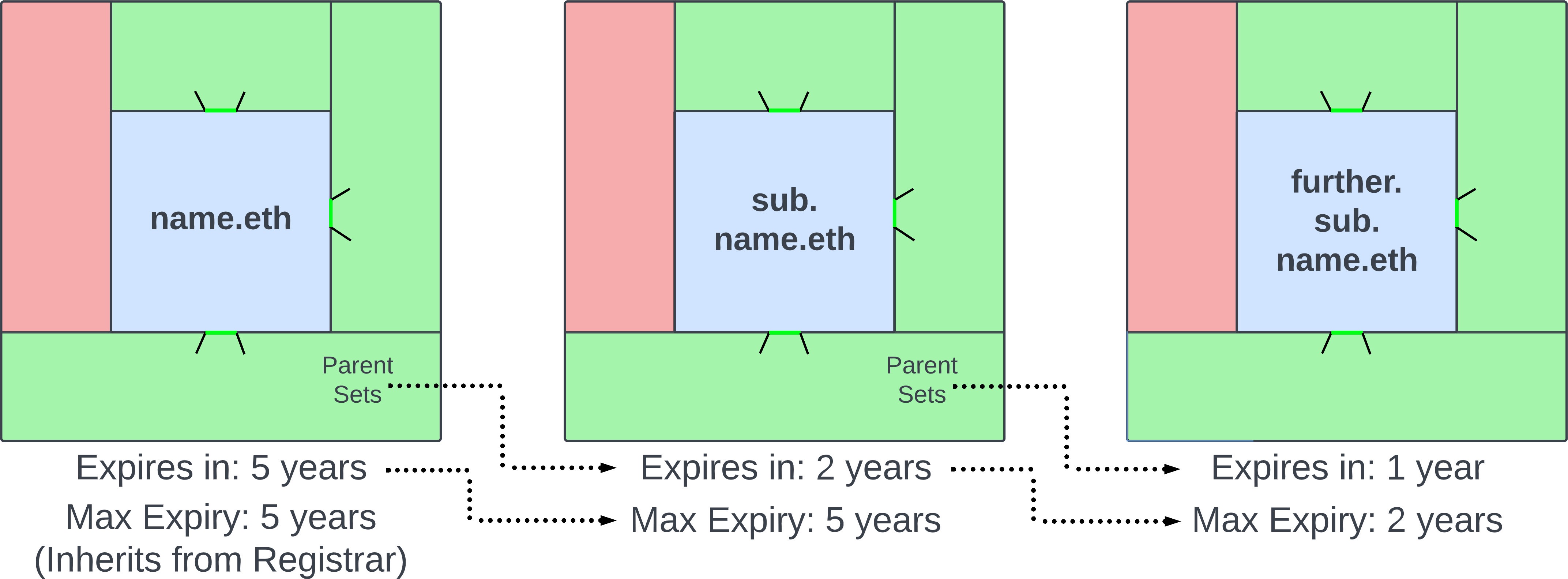Name Wrapper Expiry
In order to burn any fuses on a name, you must also set an expiry on it. This expiry determines how long any burned fuses are active for, and may also determine whether the name itself has expired.
If the name is a .eth 2LD, then the expiry will automatically be set to the same expiry in the .eth Registrar. But for all other names, the parent can choose what expiry to set for a child name.
Max Expiry for Subnames
By default, the expiry for a name can only be set by the parent, and can only be increased, not decreased. The maximum value for the expiry of a name is the expiry of its parent name.
For example, say a name expires in 5 years. The owner of the name can then set the expiry of its subnames to a maximum of 5 years as well. But the parent could also choose to set the expiry to something less. Let's say the parent sets the expiry of one of its subnames to 2 years.
Then in turn, the owner of the subname can set the expiry of its own subnames up to a maximum of 2 years, but it could also set it to something less, like 1 year.

The parent can set a different expiry for different subnames too, just as it can burn different fuses for different subnames.
Renewals
When a wrapped .eth second-level name (like name.eth) is renewed, that new expiry is automatically set in the Name Wrapper as well as in the .eth Registrar. However, the expiry for any other .eth names (like sub.name.eth) will not be automatically extended when the parent expiry is extended.
The parent can extend the expiry for an existing subname at any time, even if the subname has been emancipated.
The parent can also choose to approve a separate contract to allow the expiry for subnames to be extended by the subname owner or other accounts.
That is basically how .eth second-level names work: Since the eth node is locked in the registrar contract and has the Name Wrapper (which exposes a renew method) approved as a controller, .eth second-level names can be directly renewed by their owners.
The parent can further lock this approved contract in by burning the CANNOT_APPROVE fuse.
There is also a special parent-controlled fuse called CAN_EXTEND_EXPIRY. If the parent burns this fuse on a subname, then the owner of that subname (or any approved controller) can also extend the expiry.
So, if you are running a subname registrar and you want to enable "unruggable renewals", you can use one of the above options (or both).
Special Cases for .eth 2LDs
For .eth second-level names, the end of the name's grace period (from the .eth Registrar) is used for the expiry inside of the Name Wrapper.
So if the name's expiration date in the Registrar is January 1st, then the expiry in the Name Wrapper will reflect that date plus the grace period (currently 90 days, so approximately April 1st, depending on the year).
When the name's expiration date (from the .eth Registrar) has been reached, and the name is now in the grace period, all Name Wrapper operations on the name will be restricted.
The owner will not yet lose ownership of the name, but they will also not be able to unwrap or update the name until it has been renewed.
Expiry Implications
When a name is merely Wrapped but not Emancipated or Locked, parent-controlled fuses can still be burned. This means that the parent can burn a custom fuse for a limited amount of time.
When the expiry (end of grace period for .eth 2LDs) is reached, all fuses will be reset, but the name will otherwise be unaffected.
When a name is Emancipated or Locked, the expiry has an important additional effect. In this scenario, when the expiry (end of grace period for .eth 2LDs) has been reached, the name itself will expire, and the owner loses ownership of the name.
